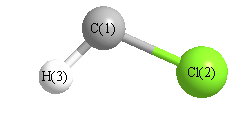Jump to
S2C1
Energy calculated at CCD/6-311G**
| | hartrees |
|---|
| Energy at 0K | -498.116297 |
| Energy at 298.15K | -498.116170 |
| HF Energy | -497.833450 |
| Nuclear repulsion energy | 38.590525 |
The energy at 298.15K was derived from the energy at 0K
and an integrated heat capacity that used the calculated vibrational frequencies.
Geometric Data calculated at CCD/6-311G**
Point Group is Cs
Cartesians (Å)
| Atom |
x (Å) |
y (Å) |
z (Å) |
|---|
| C1 |
0.045 |
1.196 |
0.000 |
| Cl2 |
0.045 |
-0.507 |
0.000 |
| H3 |
-1.041 |
1.435 |
0.000 |
Atom - Atom Distances (Å)
| |
C1 |
Cl2 |
H3 |
| C1 | | 1.7032 | 1.1120 |
Cl2 | 1.7032 | | 2.2246 | H3 | 1.1120 | 2.2246 | |
 More geometry information
More geometry information
Calculated Bond Angles
| atom1 |
atom2 |
atom3 |
angle |
|
atom1 |
atom2 |
atom3 |
angle |
| Cl2 |
C1 |
H3 |
102.369 |
|
Electronic energy levels
Charges, Dipole, Quadrupole and Polarizability
Jump to
S1C1
Energy calculated at CCD/6-311G**
| | hartrees |
|---|
| Energy at 0K | -498.113846 |
| Energy at 298.15K | -498.113709 |
| HF Energy | -497.859576 |
| Nuclear repulsion energy | 38.729978 |
The energy at 298.15K was derived from the energy at 0K
and an integrated heat capacity that used the calculated vibrational frequencies.
Geometric Data calculated at CCD/6-311G**
Point Group is Cs
Cartesians (Å)
| Atom |
x (Å) |
y (Å) |
z (Å) |
|---|
| C1 |
0.037 |
1.162 |
0.000 |
| Cl2 |
0.037 |
-0.516 |
0.000 |
| H3 |
-0.842 |
1.799 |
0.000 |
Atom - Atom Distances (Å)
| |
C1 |
Cl2 |
H3 |
| C1 | | 1.6779 | 1.0846 |
Cl2 | 1.6779 | | 2.4755 | H3 | 1.0846 | 2.4755 | |
 More geometry information
More geometry information
Calculated Bond Angles
| atom1 |
atom2 |
atom3 |
angle |
|
atom1 |
atom2 |
atom3 |
angle |
| Cl2 |
C1 |
H3 |
125.941 |
|
Electronic energy levels
Charges, Dipole, Quadrupole and Polarizability
